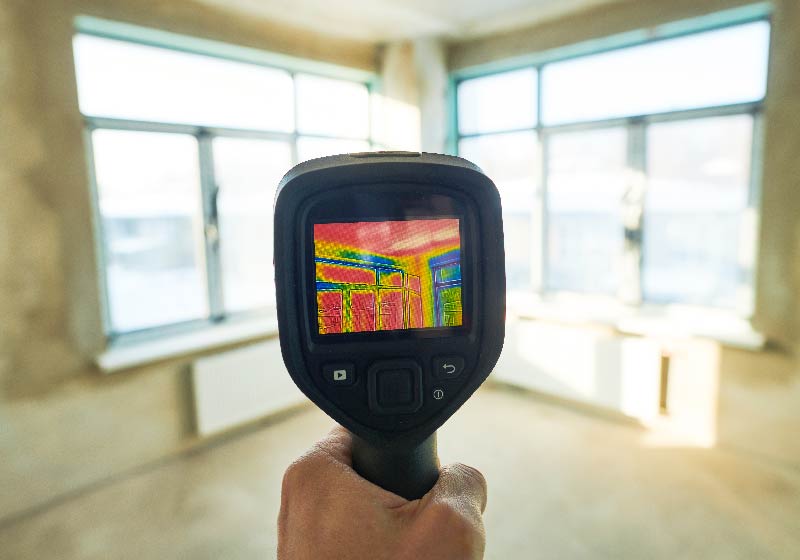By Jon McCreath, NPI, Inc.’s Technical & Training Director
Inspectors are usually excited to experiment with the many tools of the trade, from sewer scope cameras to moisture meters to drones. The right tool can dramatically increase the value of an inspector’s final report. The only issue? Too many home inspectors will add a new gadget to their toolbelt without really understanding how to use it!
One device that we see far too many inspectors incorporate into their process without having a sufficient understanding of is the infrared camera. In the property inspection industry, the use of an infrared camera (and other complementary equipment) and the interpretation of the images the camera produces is referred to as thermography (also, thermal imaging).
With the right training, inspectors can use their infrared cameras to add valuable insights to their reports, and avoid the common misinterpretations and misdiagnoses that untrained home inspectors make all the time. If you haven’t invested in an infrared camera yet, or you haven’t pursued thermography training yet, here are a few reasons why you should.
What is Thermography, Anyway?
As previously mentioned, thermography refers to the use of infrared/thermal imaging cameras and the interpretation of their output. Infrared cameras are designed to detect temperature differences across surfaces, which are translated into a color spectrum: whites and reds being hot, and blue shades being cool.
Thermography is used in a variety of fields, including wildlife conservation, law enforcement, and medical diagnosis. In the world of building inspections, thermal imaging can help identify safety and maintenance concerns such as moisture intrusion, air leakage, and electrical issues (hello, fire hazards!).
Like many modern inspection tools, it’s common for home inspectors to simply add their new tools to their basic inspection package and either raise their base prices or enjoy the extra business that comes from differentiating themselves from their competition. In some areas, thermal imaging might be offered as a stand-alone add-on as well, and advanced certifications can open the door for other lucrative opportunities.
Levels of Thermography Certification
The primary issue with thermography in property inspections is that many inspectors don’t seek out any training to know how to use their infrared camera or correctly interpret the produced images. Thermography certifications can be earned through both in-person and online courses and are divided into a few different levels:
- Level-1 Thermography Certification starts inspectors out with the basics of thermodynamics and the principles of heat transfer. Achieving a level of certification can take an inspector from using their infrared camera as just another tool in their collection, to offering thermal imaging inspections as a stand-alone service on commercial properties. Note: It is very rare to find a home inspector that is also a level-1 thermographer!
- Level-2 Thermography Certification takes what inspectors learn during level-1 and brings everything to the next level. Your measurements via thermography will be more accurate after completing this certification, and you’ll have a fuller understanding of the science that determines how your infrared images look. Certain commercial jobs will require level-2 certification.
- Level-3 Thermography Certification is for any inspector who is ready to pursue instructor roles and train others on how to practice thermography. This is the highest level of thermography certification available.
- Basic Thermography Training will give inspectors the information they need to not fall into the common pitfalls of misinterpretations and misdiagnoses that are so common from those that don’t understand the factors that skew thermal image readings. For residential inspections, basic thermography training should be sufficient to provide valuable context to inspection reports, while also avoiding costly errors on the part of the inspector.
Factors That Can Lead to Misinterpretation
After completing (at minimum) a basic thermography training course, home inspectors can start to interpret with much more accuracy, bringing the many factors that lead to common confusion under appropriate consideration. The key to using an infrared camera best in property inspections comes down to two main things: using your camera strategically and in conjunction with other tools (like moisture meters or hygrometers), and understanding how the environment affects your readings (the context).
The first factor that every adroit thermographer should take into account is a term called emissivity. For our purposes, emissivity refers to how different building materials reflect heat at different rates (for example, materials like metal have low emissivity while brick walls will have high emissivity). Experienced thermographers take materials into account when using infrared cameras.
To account for emissivity, one pro tip is to cover a low-emissivity object with electrical tape. This strategy is a simple way to produce a more accurate reading!
In addition to emissivity, building materials will all have varying levels of reflectivity and transmissivity. Some materials that most people would think are very transmissive are not (like windows), and others that seem opaque, may be incredibly transmissive (like thin plastic). An inspector with the right training can take all of these factors into account for far more accurate thermal imaging interpretations.
After understanding the nature of building materials, home inspectors also need to take weather conditions into account such as wind, rain, and the sun. “Leaky” homes that easily allow air to enter through transition points can appear as though they are taking on moisture, and many inspectors will opt to scan building exteriors at dusk in order to reduce the skewing influence the sun may have.
Other factors that inspectors should consider when operating infrared cameras include the presence of moisture, frost or snow on surfaces, as well as dirt and other debris that may increase emissivity.
Today, many inspectors use infrared cameras, but few know how to use them right by factoring in the necessary context. If you’re a home inspector that hasn’t taken the plunge yet, let this be your first signal to make a change and get your training. Your clients will thank you!
For more technical advice as well as marketing and business development topics for the inspection industry, you’re in the right place! Interested in joining NPI? Get linked up with someone from our recruitment team today and claim your free info packet!



